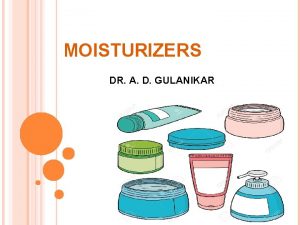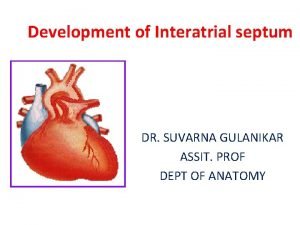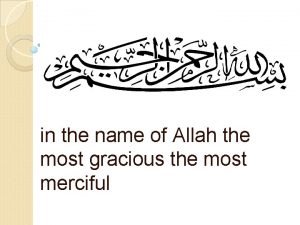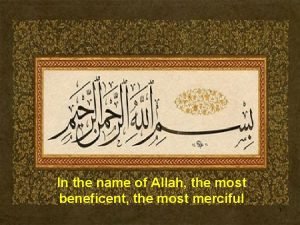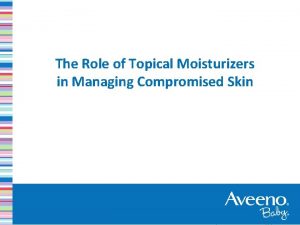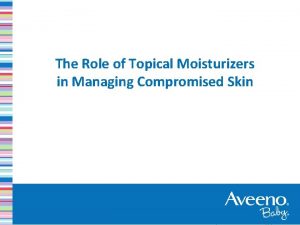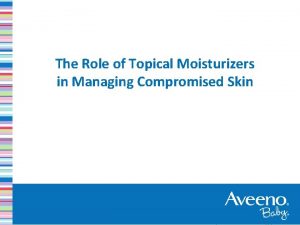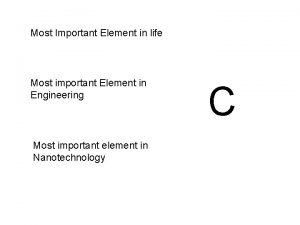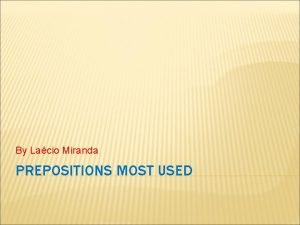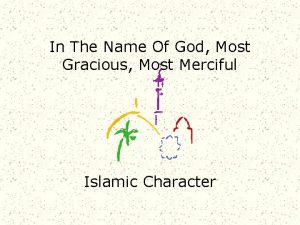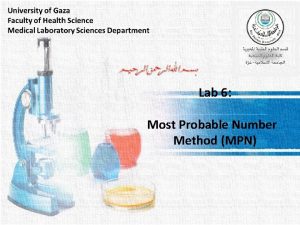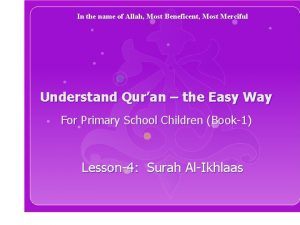MOISTURIZERS DR A D GULANIKAR INTRODUCTION The most

















































- Slides: 49

MOISTURIZERS DR. A. D. GULANIKAR

INTRODUCTION The most prescribed products in dermatology practice. Agents which make the stratum corneum soft and pliable by increasing hydration. They help the skin to retain water by decreasing transepidermal water loss.

SKIN BARRIER The epidermis is often called as “Skin Barrier” because of its actions -protection from environmental stimuli -prevent water loss -skin hydration Peter Elias& his co-workers first described “Brick and Mortar” model of epidermis.

BRICK AND MORTAR MODEL OF S. C.

NMF(NATURAL MOISTURISING FACTOR) Produced by filaggrin degradation within corneocytes. Consists of -amino acids -pyrrolidone carboxylic acid -lactate -urea -Electrolytes -Ca, Mg, Po 4 -sugars Function- hydration of stratum corneum.

LAMELLAR BODIES Also called as odland bodies/ cementosomes/ keratinosomes/ membrane-coating granules. Synthesized and secreted by uppermost layer of stratum granulosum. Functions -cohesion of corneocytes -regulation of keratinocyte desquamation -cornification -skin barrier formation -hydration -antimicrobial actions.

TRANSEPIDERMAL WATER LOSS It is defined as the constitutive steady state water loss from skin surface(excluding sweating). Used to study the integrity of skin barrier.

CLASSIFICATION Four types Occlusive Humectants Emollients Rejuvenators

OCCLUSIVES Create a hydrophobic barrier over skin surface. Block TEWL. Prevent evaporation. They will have most pronounced effect when applied on slightly dampened skin.

Petrolatum is most effective amongst all, reduces TEWL to 98%. Dimethicone: silicone based, oil free, hypoallergic but can’t reduce TEWL. Used in dry and damaged skin. Limitations- odour, greasy feel, contact dermatitis.

VARIOUS CLASSES OF OCCLUSIVES

HUMECTANTS These attract water from two sources 1)from dermis to epidermis. 2)in humid conditions from environment. Acts as double edged weapons. TEWL by enhancing water absorption from dermis to epidermis where it gets easily lost to environment. Always combined with occlusives. Suitable for daily use.

EXAMPLES OF HUMECTANTS

EMOLLIENTS Improves the texture and appearance of skin by filling gaps between corneocytes. Improves lubricity and restore epidermal lipids making skin soft& supple.

EXAMPLES OF EMOLLIENTS

REJUVENATORS These are the proteins, helps in rejuvenating essential proteins in the skin Eg. Collagen, keratin, elastin etc.

Occlusive Humectant Emollient Rejuvenat ors Mech. of action Forms hydrophobic layer on skin surface Enhances water absorption from dermis to epidermis Fills gaps between corneocytes Replenish essential proteins in the skin Indicatio ns Xerosis, Atopic dermatitis, Prevention of contact dermatitis Xerosis, icthyosis Routine skin care, skin dryness, roughness, papulosquamous disorders Skin rejuvenation, Aging, Photodamaged skin Adverse effects Cosmetically unacceptable, Folliculitis, Acneiform eruption, Contact Irritation to urea & Rare lactic acid Contact dermatitis

THERAPEUTIC MOISTURIZERS 1) Sodium PCA : - Functions as humectant& acts like duplicate dermis; mimicking its property of possesing GAGS& holding water. 2) Urea : - Acts as humectant at lower concentration(5%) and keratolytic at higher concentration(10%) 3)Alpha & Beta hyddroxy acids : - Anti aging - Exfolient

4)Physiological lipids 5)Vitamins 6)Panthenol 7) Niacinamide

AN IDEAL MOISTURIZER SHOULD Reduce and prevent further TEWL. Restore lipid barrier, i. e. , duplicating and enhancing the skin's moisturizing retention mechanisms. Hypo-allergenic, non-sensitizing, fragrance free. Absorbed immediately, providing immediate hydration. Cosmetically acceptable. Affordable.

ROLE OF MOISTURIZERS Moisturising action- most vital action by which they increase water content of SC Anti-inflammatory action- inhibit production of proinflammatory prostanoids by blocking cyclooxygenase activity. Antipruritic action- downregulates cytokines Antimitotic action: Moisturizers containing mineral oils have low-grade anti-mitotic action on the epidermis.

Photo protective action Antimicrobial- act against skin surface microbes Wound healing- hyluronic acid Improves quality of life.

INDICATIONS Indications Examples Dry skin winter season, genetic , diabetes, uremia , hypothyroidism, hepatic disorder, exfoliative dermatitis etc Eczema Atopic dermatitis, asteatotic eczema, hand eczema, lichen simplex chronicus etc Disorders of keratinization Icthyosis, psoriasis, keratosis pilaris, palmoplantar keratoderma, lichen planus etc Acne treated with retinoids, rosacea etc Aging Chronic pruritus in elderly, photoaged skin, atrophic vaginitis etc Miscellaneous Hair, nail, contact dermatitis, scars, straie etc

1)ATOPIC DERMATITIS Emollients should be applied after any topical pharmacologic therapies for improved absorption of active medication 3 minute rule of application. Avoid products containing topical sensitisers(fragrance, benzocaine, neomycin)

Note: Emollients and moisturizers can’t cure AD flares; in fact they can sometimes exacerbate AD when applied at “wrong” moment (the sole use of emollient without sufficient topical anti inflammatory therapy) The products containing SC specific lipids(NMF, ceramides, pueudoceramides) have better role in AD. Petrolatum based preparations have been the workhorse for flare prevention in AD Products available: atogla cream, nevlon cream, venusia cream, physiogel cream, cetaphil restoraderm etc

2) ACNE Constituents of moisturisers used are 1. Silicone derivatives: - dimethocone, cyclomethicone - have non-comedogenic, hypoallergic, emollient, occlusive properties. 2. Glycerin : -most effective humectant. -used in combination with HA & sodium PCA.

3. Alpha hydroxy acids: -salicylic acid, glycolic acid -has anti inflammatory properties. 4. Jojoba oil: -wax ester, contains tocopherols, sterols etc -anti inflammatory, anti bacterial, photoprotective

4. Sesame oil: -composed of TGs of oleic acid, linoleic acid& saturated fats. -contains vitamin E, antioxidants & has oil pulling properties. 5. Botanical extracts& metals: -aloevera, green tea, allantoin, lichochalcone, zinc, copper, selenium, aluminium, strontium etc. -has soothing, anti inflammatory properties.

3)ROSACEA& SENSITIVE SKIN -Urea and alpha hydroxy acids containing products are avoided. -Occlusives: petrolatum& dimethicone most commonly used. -Humectants: glycerine, propylene glycol, sod. PCA, HA, ammonium lactate etc -Emollients: mineral oils, cholesterol, squalene etc

4)XEROTIC & ICHTHYOTIC SKIN -Therapeutic moisturizers are best suited. -Eg. Sodium pyrrolidone carboxylic acid, urea, alpha hydroxy acids, panthenol, vit E, ceramides, glycerol glucoside, white soft paraffin etc Products available are : U-lac cream, xerolene cream, NMF e Urea cream, moisturex cream, xerina cream, dewderm cream etc

Special considerations while choosing moisturizer in ichthyotic patient: 1. lactic acid 5 -10% and/or urea 5 -10% compounded in moisture base 2. combination using salicylic acid 5 -10% and urea 5 -10% can be compounded in either an ointment or a cream 3. for keratoderma of soles, 50% salicylic acid+20%urea in white petroleum jelly applied nightly.

5)HAND ECZEMA -Moisturizers and barrier creams are used. -Nearly all moisturizers available in market are a combination of emollients, occlusives and humectants. -Products available in India: cetaphil cream, occlubase cream, venusia max cream, oilatum cream , elovera cream etc

6)HYPERPIGMENTARY CONDITIONS -Most common are melasma and postinfflamatory hyperpigmentation. -Components commonly used are 1. aloevera gel : photoprotective anti inflammatory stimulates fibroblasts 2. niacinamide : active form of vit B 3 anti inflammatory inhibit transfer of melanosomes.

3. vitamin C : antioxidant inhibit melanogenesis Products available: excela moisturizer, ilumax cream, sabiglow cream, facemoist cream, aloederm cream etc.

7)NEONATES AND INFANTS -Hydrocarbons are most effective eg. vaseline, paraffin, petrolatum, mineral and baby oils -Second most effective are fatty alcohols, humectants, coconut oil, sunflower oil etc -Products available: atogla cream, sebamed cream, nevlon cream, dermadew baby cream etc

8)GERIATRIC -The ideal moisturizer should 1. repair lipid barrier 2. repair stratum corneum 3. supply and retention of water to stratum corneum 4. reduce pruritus

Components -Hydrants(amino acids, NMF: Urea, hyluronic acid) -Physiologic humectant(glycerol, paraffin, vaseline, ) -Physiologic lipids(ceramides, cholesterol, free fatty acids) -Anti pruritic agents(glycine, glycerol, calamine)

9)SEASONAL -Humectants : avoided in dry areas and winter season -Occlusives : avoided in summer, suitable for winter season -Emollients : suitable for individuals prone to skin hyper reactivity eg. squalene, cholesterol, hyluronic acid -NMF : used in patients with xerosis, atopic dermatitis, sensitive skin

10) HAIR -Humectants are most commonly used. (Glycerin, propylene glycol, sodium PCA, honey, panthenol etc) -Should be used with caution in extreme weather. -Emollients : forms a coat and heps in detangling, smoothening hair. (silicones, mineral oils, petrolatum, fatty alcohols etc)

METHOD OF APPLICATION The skin should be moistened as after dabbing it following a bath or by rubbing a wet cloth (sponge bath). After rubbing the moisturizer in both palms, should be lightly applied along the direction hair follicles. Depending on the severity of xerosis, the frequency of application can vary between 1 and 3 times daily, especially after bath. it of the

SPECIAL ADDITIVES 1) Botanical substances -Aloevera: most famous -Allantoin (comfrey root): moisturizer as well as keratolytic, anti inflammatory, antiaging properties. -Honey: antioxidant, anti microbial, humectant, photoprotective.

-Jojoba oil: liquid wax which solidifies at room temperature. It acts as emollient -Oatmeal (Avena sativa): for soothing rashes -Bioflavonoids, i. e. , plant derived polyphenols are being promoted as topical antioxidants. -Shea butter: derived from kernel of shea tree. It act as emollient.

2) Antioxidants - Tocopherols (Vitamin E), butylated hydroxytoluene, alkyl gallates , ascorbic acid 3) Chelating agents: -Citric acid, tartaric acid ethylenediaminetetraacetic acid, and its salts 4) Vitamins-Vitamin A, C, E, Niacinamide(active form of vitamin B 3)

5) Fragrances and coloring agents: - Cinnamic acid, cinnamates, menthol, benzoin resin 6) Preservatives: - Phenoxyethanol and parabens (methyl-, propyl, ethyl- and butyl-paraben 7) Emulsifying agents: - laureth 4 and 9, ethylene glycol monostearate, octoxinols, and nonoxinols. 8) Sunscreens

ADVERSE EFFECTS

MYTHS & MISCONCEPTIONS Myth: Oily skin doesn’t need moisturising. Truth: Oily skin too needs moisturization. Completely drying out oily skin send a signal to the sebaceous glands to produce even more oil. Myth: All moisturizers are essentially the same. Truth: There are multitude of moisturizers available with different ingredients, purposes, outcomes.

Myth: Same moisturizer can be used for different body parts. Truth: Face needs an oil-free moisturizer, as it is rich in sebaceous glands& is more prone to acne. Myth: Creams are more efficacious than lotions. Truth: Creams are thicker emulsion system than lotions; however, they don’t necessarily contain higher concentration of active ingredient or offer better protection.

Myth: If moisturizer contains sunscreen, you don’t need any other protection. Truth: As long as sunscreen is broad spectrum and has a SPF of 30 or higher. Myth: All cases of facial dryness need to be moisturized. Truth: The distinction between true dry skin& dehydrated skin is important. Regular& through exfoliation is required to reduce dehydration.

 Dimethocone
Dimethocone Septum primum
Septum primum Hát kết hợp bộ gõ cơ thể
Hát kết hợp bộ gõ cơ thể Slidetodoc
Slidetodoc Bổ thể
Bổ thể Tỉ lệ cơ thể trẻ em
Tỉ lệ cơ thể trẻ em Voi kéo gỗ như thế nào
Voi kéo gỗ như thế nào Tư thế worm breton
Tư thế worm breton Hát lên người ơi alleluia
Hát lên người ơi alleluia Các môn thể thao bắt đầu bằng tiếng chạy
Các môn thể thao bắt đầu bằng tiếng chạy Thế nào là hệ số cao nhất
Thế nào là hệ số cao nhất Các châu lục và đại dương trên thế giới
Các châu lục và đại dương trên thế giới Cong thức tính động năng
Cong thức tính động năng Trời xanh đây là của chúng ta thể thơ
Trời xanh đây là của chúng ta thể thơ Mật thư anh em như thể tay chân
Mật thư anh em như thể tay chân 101012 bằng
101012 bằng độ dài liên kết
độ dài liên kết Các châu lục và đại dương trên thế giới
Các châu lục và đại dương trên thế giới Thơ thất ngôn tứ tuyệt đường luật
Thơ thất ngôn tứ tuyệt đường luật Quá trình desamine hóa có thể tạo ra
Quá trình desamine hóa có thể tạo ra Một số thể thơ truyền thống
Một số thể thơ truyền thống Cái miệng bé xinh thế chỉ nói điều hay thôi
Cái miệng bé xinh thế chỉ nói điều hay thôi Vẽ hình chiếu vuông góc của vật thể sau
Vẽ hình chiếu vuông góc của vật thể sau Thế nào là sự mỏi cơ
Thế nào là sự mỏi cơ đặc điểm cơ thể của người tối cổ
đặc điểm cơ thể của người tối cổ Thế nào là giọng cùng tên
Thế nào là giọng cùng tên Vẽ hình chiếu đứng bằng cạnh của vật thể
Vẽ hình chiếu đứng bằng cạnh của vật thể Phối cảnh
Phối cảnh Thẻ vin
Thẻ vin đại từ thay thế
đại từ thay thế điện thế nghỉ
điện thế nghỉ Tư thế ngồi viết
Tư thế ngồi viết Diễn thế sinh thái là
Diễn thế sinh thái là Các loại đột biến cấu trúc nhiễm sắc thể
Các loại đột biến cấu trúc nhiễm sắc thể Số nguyên tố là gì
Số nguyên tố là gì Tư thế ngồi viết
Tư thế ngồi viết Lời thề hippocrates
Lời thề hippocrates Thiếu nhi thế giới liên hoan
Thiếu nhi thế giới liên hoan ưu thế lai là gì
ưu thế lai là gì Hổ đẻ mỗi lứa mấy con
Hổ đẻ mỗi lứa mấy con Khi nào hổ con có thể sống độc lập
Khi nào hổ con có thể sống độc lập Sơ đồ cơ thể người
Sơ đồ cơ thể người Từ ngữ thể hiện lòng nhân hậu
Từ ngữ thể hiện lòng nhân hậu Thế nào là mạng điện lắp đặt kiểu nổi
Thế nào là mạng điện lắp đặt kiểu nổi Most general to most specific classification
Most general to most specific classification Most general to most specific classification
Most general to most specific classification Almighty allah the most merciful
Almighty allah the most merciful The most
The most Beneficent pronunciation
Beneficent pronunciation Guddi baji
Guddi baji
